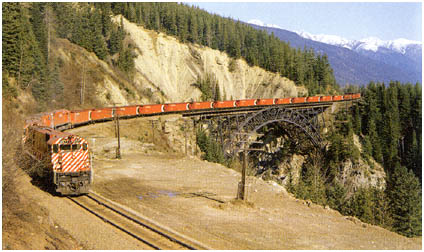|
Fall
2004

Canadian
Pacific Railway Employee Communications
Room 500 401-9th Ave S.W. Calgary AB T2P
4Z4
The Big Alco/MLW
Units
By Jonathan Hanna

Alco/MLW
locomotive pulls a unit coal train across Stoney Creek Bridge.
High maintenance costs squandered
their potential in bulk commodity unit train service
CPR's General Motors (GM) SD40 locomotives had wheel-slippage woes,
excessive assembly wear, and turbocharger failures.
So CPR's next high-horsepower locomotive orders in the late 1960s went
to the other large Canadian locomotive manufacturer, GM's competitor, Montreal
Locomotive Works (MLW), the Canadian manufacturing arm of the American Locomotive
Company (Alco). CPR ordered Alco/MLW's 3,000-h.p. models, with their
highly touted high-adhesion trucks.
Having tested two Union Pacific C-630 locomotives in 1966, CPR ordered
eight locomotives from Alco/MLW. These arrived in 1968, the last new locomotives
delivered in the now historic tuscan-and-grey paint scheme. CPR saw
Alco/MLWs as the answer to its bulk commodity unit train needs.
Extra enticements like lower fuel consumption and a $50,000 trade-in
on old Canadian Locomotive Company Train Master traction motors also helped.
Although MLW's four-cycle engine was supposed to save on fuel, its high
lubrication oil consumption and the highest per-mile maintenance cost
of any class in the CPR fleet more than offset any potential savings.
Meanwhile GM had fixed their wheel slippage woes and introduced their new
SD40-2 model in 1972. These SD40-2 locomotives rapidly
displaced the 3,000-h.p. Alco/MLWs on the coveted
coal-haul route. The latter were gradually cycled out of coal service
and relegated to general freight service, mostly east of Winnipeg.
In the east, the high-horsepower Alco/MLWs regularly operated through
Maine to Saint John, N.B. The introduction of RailRunner service between Montreal
and Chicago, in the 1980s, saw high-horsepower Alco/MLWs run through
to Chicago. CPR purchased the remaining shares of the SOO Line and of the bankrupt
Delaware & Hudson at the beginning of the 1990s. And that made
high-horsepower Alco/MLWs regular visitors to Chicago, and even New
Jersey, and Pennsylvania.
But high maintenance and excessive failures sounded the death-knell
for high-horsepower Alco/MLWs. And they were gradually withdrawn from
service, the last in December 1993. CPR president Rob Ritchie pressed the fuel
cut-off button and shut down the last Alco-engined,
high-horsepower M-636: No. 4706.
However, in the spring of 1994, with an upsurge in traffic and a shortage of power,
CPR reactivated 33 Alco/MLW locomotives temporarily. They were all withdrawn on
31 Aug 1995, with the exception of No. 4711 that had years before been
outfitted with a million-dollar Caterpillar engine.
Nos. 4500, 4563, 4711, 4723, 4743 and 4744 have all been saved. The rest of the
Alco/MLW fleet was scrapped off-site or dismantled at CPR's Angus
Shops.
| |
Vital
Statistics
|
Numbers
|
4500-4744
|
Class
|
DRF-30c to
DRF-30f and
DRF-36a to
DRF-36d
|
Builder
|
Montreal Locomotive
Works (MLW)
|
Outshopped
|
1968-1971
|
Builder's
Models
|
C-630M,
M-630, M-636,
M-640
|
Horsepower
|
3,000, 3,600, 4,000
|
Cylinders
|
16 (No. 4744 -
18)
|
Axles
|
6
|
Maximum
speed
|
75 mph
(120 kph)
|
Length
|
69 ft. 6 in.
(21.2 m)
|
Width
|
10 ft. 5 3/8 in.
(3.2 m)
|
Height
|
15 ft. 6 in.
(4.7 m)
|
Weight
|
391,000-396,000 lbs.
(177,350-179,625 kg)
|
Purchase
price
|
$343,364 to $409,494
|
This CP Rail News article is copyright 2005 by
Canadian Pacific Railway and is reprinted here with their permission. All
photographs, logos, and trademarks are the property of the Canadian
Pacific Railway Company.
|